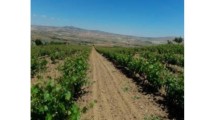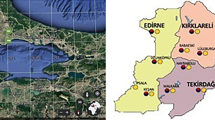Abstract
The aim of this research was to determine the amount of energy input and output used for grapefruit production in the province of Hatay, one of the most important citrus production centers in Turkey, and to conduct energy efficiency and environmental price analyses accordingly. This study was performed for the 2020 production season in Arsuz, Erzin, Dörtyol, and Samandağ towns in Hatay province. The data were collected from 42 different grapefruit growers by using a face-to-face questionnaire method. The agricultural input values, input energies, output values, and output energies used in grapefruit production were computed to determine the energy efficiency. Also, environmental prices were calculated depending on greenhouse gas (GHG) emission of agricultural inputs. According to the results of the research, the energy input was found to be 60,944.87 MJ ha−1, and the output was 107,982.64 MJ ha−1 in grapefruit production. The environmental price was 464 € ha−1, and the total GHG emission was calculated as 8140.35 kgCO2‑eq ha−1. Electricity consumption accounted for 42.06% of the total GHG emissions in grapefruit production. This was followed by the use of nitrogen fertilizer, at 16.94%. The GHG ratio was found to be 0.13 kgCO2‑eq kg−1. Energy use efficiency, specific energy, energy efficiency, and net energy value were determined as 1.77, 0.96 MJ kg−1, 1.04 kg MJ−1, and 47,037.77 MJ ha−1, respectively. The renewable energy usage rate was 14.14% of the total energy input. Energy efficiency should be increased in grapefruit production, and more renewable energy should be used for sustainable agriculture and a clean environment.



Similar content being viewed by others
References
Akcaöz H, Özçatalbaş O, Kızılay H (2009) Analysis of energy use for pomegranate production in Turkey. J Food Agric Environ 7:475–480
Anonymous (2020) Hatay directorate of provincial agriculture and forestry annual report for 2020. https://hatay.tarimorman.gov.tr/Menu/55/Tarimsal-Veriler. Accessed 19 Feb 2022 (in Turkish)
Aygören E (2021) Citrus product repor. https://arastirma.tarimorman.gov.tr/tepge/Belgeler/PDF%20%C3%9Cr%C3%BCn%20Raporlar%C4%B1/2021%20%C3%9Cr%C3%BCn%20Raporlar%C4%B1/Turun%C3%A7giller%20%C3%9Cr%C3%BCn%20Raporu%202021-333%20TEPGE.pdf. Accessed 19 Feb 2022 (in Turkish)
Baran MF, Eren O, Gökdoğan O, Oğuz HI (2020) Determination of energy efficiency and greenhouse gas (GHG) emissions in organic almond production in Turkey. Erwerbs-Obstbau 62:341–346
Bilgili ME (2021) Energy use efficiency of mandarin production: A case study from Adana province. Erwerbs-Obstbau 63:61–64
BioGrace-II (2015) Harmonised calculations of biofuel greenhouse gas emissions in Europe. http://www.biograce.net. Accessed 12 Jan 2022 (BioGrace, Utrecht, The Netherlands)
Bruyn ST, Ahdour S, Bijleveld M, De Graaff L, Schep E, Schroten A, Vergeer R (2018) Environmental prices handbook. Methods and numbers for valuation of environmental impacts. CE, Delft (Publication code: 18.7N54.057)
Çicek A, Erkan O (1996) Research and Sampling Methods in Agricultural Economics. Gaziosmanpaşa University, Agricultural Faculty Publications, No 12, Lecture Notes Series 6, Tokat. (in Turkish)
Clark S, Khoshnevisan B, Sefeedpari P (2016) Energy efficiency and greenhouse gas emissions during transition to organic and reduced-input practices: student farm case study. Ecol Eng 88:186–194
Clune S, Crossin E, Verghese K (2017) Systematic review of greenhouse gas emissions for different fresh food categories. J Clean Prod 140:766–783
Dağtekin M, Bilgili ME, Beyaz A (2019) The effects of good agricultural practises on energy use effectiveness on mandarin production and environmental. Erwerbs-Obstbau 61:55–60
De D, Singh RS, Chandra H (2001) Technological impact on energy consumption in rainfed soybean cultivation in Madhya Pradesh. Appl Energy 70(3):193–213
Demircan V, Ekinci K, Keener HM, Akbolat D, Ekinci C (2006) Energy and economic analysis of sweet cherry production in Turkey: A case study from Isparta province. Energy Convers Manag 47:1761–1769
Ejilah IR, Asere AA (2008) A comparative performance and emission analysis of blended groundnut oil and mineral oil based lubricants using a spark ignition engine. Agric Eng Int Cigr E J 10:7–11
Eren Ö, Baran MF, Gökdoğan O (2019) Determination of greenhouse gas emissions (GHG) in the production of different fruits in Turkey. Fresenius Environ Bull 28(1):464–472
Farrell AE, Plevin RJ, Turner BT, Jones AD, O’Hare M, Kammen DM (2006) Ethanol can contribute to energy and environmental goals. Science 311:506–508
Ferraro DO (2003) Energy cost/use in pesticide production. In: Pimentel D (ed) Encyclopedia of pest management. Marcel Dekker, Inc, New York, pp 1–4. ISBN 0‑8247-0847‑4
Gökdoğan O, Baran MF, Eren Ö, Oğuz Hİ (2022) Determination of energy use efficiency and greenhouse gas (GHG) emissions of pistachio (Pistacia vera L.) production in Adıyaman province. Erwerbs-Obstbau 64: 91–297
Houshyar E, Dalgaard T, Tarazgar MH, Jorgensen U (2015) Energy input for tomato production what economy says, and what is good for the environment. J Clean Prod 89:99–109
Houshyar E, Mahmoodi-Eshkaftaki M, Azadi H (2017) Impacts of technological change on energy use efficiency and GHG mitigation of pomegranate: Application of dynamic data envelopment analysis models. J Clean Prod 162:1180–1191
Hughes DJ, West JS, Atkins SD, Gladders P, Jeger MJ, Fitt BD (2011) Effects of disease control by fungicides on greenhouse gas emissions by U.K. arable crop production. Pest Manag Sci 67:1082–1092
Karabat S, Aydın B (2018) Effect of good agricultural practices on energy use efficiency and economic analysis in mandarin farming: Case of İzmir province. Soil Water Journal 7(1):1–10 (in Turkish)
Khoshnevisan B, Shariati HM, Rafiee S, Mousazadeh H (2014) Comparison of energy consumption and GHG emissions of open field and greenhouse strawberry production. Renew Sustain Energy Rev 29:316–324
Kordkheili P, Rahbar A (2015) Modeling and optimization of energy consumption for grapefruit production in Iran. Agric Eng Int Cigr E‑journal 17(1):118–129
Lal R (2004) Carbon emission from farm operations. Environ Int 30:981–990
Loghmanpor Zarini R, Yaghoubi H, Akram A (2013) Energy use in citrus production of Mazandaran province of Iran. African Crop Sci J 21(1):61–65
Maestre-Valero JF, Martin-Gorriz B, Nicolas E, Martinez-Mate MA, Martinez-Alvarez V (2018) Deficit irrigation with reclaimed water in a citrus orchard. Energy and greenhouse-gas emissions analysis. Agric Syst 159:93–102
Mani I, Kumar P, Panwar JS, Kant K (2007) Variation in energy consumption in production of wheat-maize with varying altitudes in hill regions of Himachal Prades, India. Energy 32:2336–2339
Maraseni TN, Cockfield G, Maroulis J, Chen G (2010) An assessment of greenhouse gas emissions from the Australian vegetables industry. J Environ Sci Health 45(6):578–588
Mardani A, Taghavifar H (2016) An overview on energy inputs and environmental emissions of grape production in West Azerbayjan of Iran. Renew Sustain Energy Rev 54:918–924
Martin-Gorriz B, Soto-García M, Martínez-Alvarez V (2014) Energy and greenhouse-gas emissions in irrigated agriculture of SE (southeast) Spain. Effects of alternative water supply scenarios. Energy 77:478–488
Mohammadshirazi A, Akram A, Rafiee S, Kalhor EB (2015) On the study of energy and cost analyses of orange production in Mazandaran province. Sustain Energy Technol Assess 10:22–28
Namdari M, Kangarshahi AA, Amiri NA (2011) Input-ouput energy analysis of citrus production in Mazandaran province of Iran. Afr J Agric Res 6(11):2558–2564
Nassiri SM, Singh S (2009) Study on energy use efficiency for paddy crop using data envelopment analysis (DEA) technique. Appl Energy 86(7–8):1320–1325
Nguyen TLT, Hermansen JE (2012) System expansion for handling co-products in LCA of sugar cane bio-energy systems: GHG consequences of using molasses for ethanol production. Appl Energy 89:254–261
Özkan B, Akcaöz H, Fert C (2004) Energy inpute-output analysis in Turkish agriculture. Renew Energy 29(1):39–51
Öztürk HH (2010) Energy use in agricultural production. Hasad Yayınevi. ISBN 9758377787 (in Turkish)
Oğuz HI, Baran MF, Gökdoğan O, Eren Ö, Solak M (2022) Energy balance and greenhouse gas (GHG) emissions of organic fig (Ficus carica L.) production in Turkey. Erwerbs-Obstbau 64:61–67
Pishgar-Komleh SH, Ghahderijani M, Sefeedpari P (2012) Energy consumption and CO2 emissions analysis of potato production based on different farm size levels in Iran. J Clean Prod 33:183–191
Rafiee S, Mousavi Avval SHM, Mohammadi A (2010) Modeling and sensitivity analysis of energy inputs for apple production in Iran. Energy 35(8):3301–3306
Ramirez CA, Worrell E (2006) Feeding fossil fuels to the soil an analysis of energy embedded and technological learning in the fertilizer industry. Resour Conserv Recycl 46:75–93
Singh JM (2002) On garden energy use pattern in different cropping systems in Haryana, India. International Institute of Management University of Flensburg, Flensburg
Söyler O, Eren Ö, Uğurluay S (2022) Environmental prices and energy efficiency of mandarin (Citrus reticulata) production a case study of Hatay province Turkey. Fresenius Environ Bull 31(5):5121–5128
Stoessel F, Juraske R, Pfister S, Hellweg S (2012) Life cycle inventory and carbon and water food print of fruits and vegetables: application to a Swiss retailer. Environ Sci Technol 46:3253–3262
Turkstat (2020) Crop production statistics. https://data.tuik.gov.tr/Bulten/Index?p=Bitkisel-Uretim-Istatistikleri-2020-33737. Accessed 14 Feb 2022 (in Turkish)
USDA (2020) The United States department of agriculture. http.//www.usda.gov. Accessed 14 Feb 2022
Uysal O, Polatöz S (2017) Citrus production and foreign trade in the world and in Turkey. https://www.turktob.org.tr/dergi/makaleler/dergi22/6-11.pdf. Accessed 23 May 2021 (in Turkish)
Yılmaz H, Aydın B (2020) Comparative input-output energy analysis of citrus production in Turkey: Case of Adana province. Erwerbs-Obstbau 62:29–36
Author information
Authors and Affiliations
Corresponding author
Ethics declarations
Conflict of interest
O. Söyler, Ö. Eren, and S. Uğurluay declare that they have no competing interests.
Rights and permissions
About this article
Cite this article
Söyler, O., Eren, Ö. & Uğurluay, S. An Analysis of Energy Use Efficiency and Environmental Prices of Grapefruit (Citrus Paradisi) Production in Turkey: A Case of Hatay Province. Erwerbs-Obstbau 65, 871–878 (2023). https://doi.org/10.1007/s10341-022-00711-9
Received:
Accepted:
Published:
Issue Date:
DOI: https://doi.org/10.1007/s10341-022-00711-9




